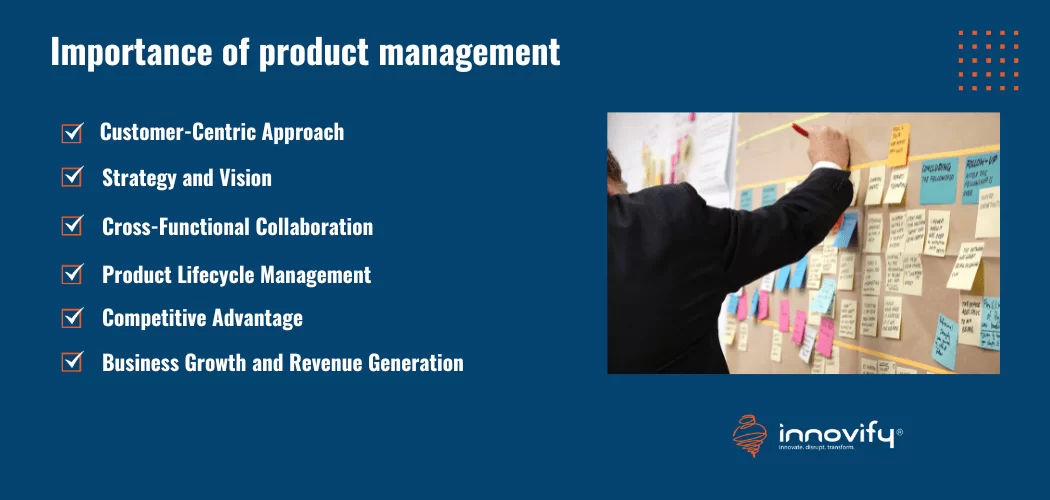Innovation
A Comprehensive Guide for Product Management
Starting a business is a big undertaking; for many entrepreneurs, it can be a risky and challenging journey. According to statistics, most startups fail within the first five years of operation, and many factors can contribute to this outcome.
One of the biggest reasons for this high failure rate is the need for more focus on the customer. With a deep understanding of the needs and preferences of their target market, many startups can create products that resonate with customers and drive sustainable growth.
That’s where product management comes in.
Product management is the process of bringing a new product to market and ensuring its success. It involves a deep understanding of the business, the user experience, and technology and requires a range of skills and expertise to be successful.
In this blog, we’ll delve into the ins and outs of product management and explore how it helps businesses thrive in a competitive market.
What is Product Management?
Product management is overseeing a product’s development and life cycle, from ideation to retirement. It involves working with cross-functional teams, such as engineering, marketing, and sales, to ensure that the product is developed and positioned to meet the target market’s needs and achieve the desired business objectives.
Product management is critical for any organization that develops and sells products. It helps align the efforts of different teams toward a common goal.
The global software products market is projected to grow at a compound annual growth rate (CAGR) of 11% from $930.93 billion in 2020 to $1493.07 billion in 2025.
As such, product managers play a key role in product management.
According to Martin Eriksson, product management is the convergence of business, user experience, and technology. Here is a brief explanation of the importance of each of these areas:

Business
Product management is ultimately about creating value for the business. This means the product must be profitable and align with the overall business strategy
User experience
A product’s success is often determined by how well it meets the needs and expectations of the user. Therefore, product managers must understand the user experience and design the product accordingly.
Technology
Technology is often a key enabler of product innovation and can help to differentiate a product from its competitors. Product managers must therefore have a strong understanding of the technology landscape and how it can be leveraged to create value for the business and the user.
Why is product management important?
Product management is crucial in various aspects of an organization’s success. Here are the key ways product management is vital:

1. Customer-Centric Approach:
It helps an organization focus on the target market’s needs and develop products that meet them. By gathering and analyzing market and customer data, product managers can identify opportunities to create value for customers and differentiate the product in the market.
2. Strategy and Vision:
It helps to align the organization around a common vision and strategy for the product. The product manager serves as the customer’s voice and helps ensure that all teams work towards a shared goal.
3. Cross-Functional Collaboration:
It helps to coordinate the work of cross-functional teams and to ensure that all necessary resources are in place to develop and deliver the product. Product managers are the glue that holds the organization together, facilitating communication and collaboration between different teams.
4. Product Lifecycle Management:
It helps to manage the product lifecycle and to ensure that the product remains competitive in the market. Product managers are responsible for tracking product performance, gathering customer feedback, and making ongoing improvements to the product.
5. Competitive Advantage:
Effective product management helps organizations differentiate their products from competitors. Product managers analyze the market landscape, identify unique selling points, and develop strategies to position the product as superior in the market. This competitive advantage enhances market share and boosts business growth.
6. Business Growth and Revenue Generation:
Product management plays a vital role in driving business growth and revenue generation. Effective product strategies, market positioning, and differentiation lead to increased market share and customer acquisition. Furthermore, product managers identify opportunities for new products, product extensions, and strategic partnerships, contributing to expanded revenue streams and overall business success.
Product management is important in a variety of different scenarios. For example:
- In a startup, product management can be critical for ensuring that the company’s limited resources are focused on developing products that will be successful in the market.
- In a large organization, product management can help ensure that different departments and teams are aligned around the goals and objectives of the product and that the product is developed in a way that meets the needs of the target market.
- In a global company, product management can help ensure that products are tailored to the needs and preferences of different global markets.
Overall, product management plays a crucial role in the development and success of a product. It helps to ensure that products are developed in a way that meets the needs of the target market and achieves the desired business objectives, and it helps to coordinate the efforts of cross-functional teams to bring a product to market.
Types of Product Management Roles
Product Manager
The Product Manager is the most common product management role, and is responsible for the entire lifecycle of a product. They are responsible for defining the product strategy, identifying customer needs, developing the product roadmap, and coordinating with cross-functional teams to ensure the product is launched successfully. The Product Manager must have a deep understanding of the market, competition, and customer needs to make informed decisions about the product’s direction. They must also have strong communication and leadership skills to collaborate effectively with different teams.
Technical Product Manager
The Technical Product Manager is responsible for managing the technical aspects of a product, such as software development, hardware design, and technical integrations. They work closely with the development team to ensure that the product is designed and developed according to the specifications and requirements. They must have a deep understanding of technology and its capabilities to identify technical solutions that can solve customer problems. They must also have strong project management skills to ensure that the product is developed on time and within budget.
UX Product Manager
The UX Product Manager is responsible for managing the user experience of a product. They work closely with designers to ensure that the product is designed with the user in mind. They conduct user research and usability testing to identify user needs and preferences and use this information to inform the product design. They must have a deep understanding of user experience principles and design thinking to create products that are easy to use and meet user needs.
Data Product Manager
The Data Product Manager is responsible for managing products that are data-driven. They work closely with data scientists to identify data sources, develop data models, and analyze data to provide insights that inform product decisions. They must have a deep understanding of data analytics, statistics, and data visualization to ensure that the product is based on accurate and actionable data.
Platform Product Manager
The Platform Product Manager is responsible for managing platform products that provide a foundation for other products to be built upon. They work closely with developers to ensure that the platform is designed to be flexible, scalable, and easy to integrate with other products. They must have a deep understanding of platform technologies and standards to ensure that the platform meets the needs of developers and other stakeholders.
Growth Product Manager
The Growth Product Manager is responsible for managing products that focus on customer acquisition, retention, and revenue growth. They work closely with the marketing and sales teams to identify opportunities for growth and develop product strategies that drive growth. They must have a deep understanding of customer behavior, marketing channels, and revenue models to develop effective growth strategies.
Hardware Product Manager
The Hardware Product Manager is responsible for managing products that are physical and tangible, such as consumer electronics, appliances, and industrial equipment. They work closely with designers and engineers to ensure that the product is designed to be functional, durable, and aesthetically pleasing. They must have a deep understanding of product design, engineering, and manufacturing to ensure that the product can be produced and shipped to customers efficiently.
5 Benefits of Product Management
The benefits of product management can be seen throughout the entire organization, from increased revenue to improved customer satisfaction. In this article, we will explore some of the most significant benefits of product management.
1. Better Product Development
One of the primary benefits of product management is that it enables better product development. Product managers work with cross-functional teams, including engineers, designers, and marketers, to ensure that products meet customer needs, are delivered on time, and are within budget.
By working closely with these teams, product managers can identify potential issues early in the development process and make necessary adjustments to ensure the product meets customer expectations. This results in a better end product that is more likely to succeed in the market.
2. Increased Revenue
Effective product management can lead to increased revenue for the organization. By developing and launching successful products, organizations can attract new customers and retain existing ones, leading to increased sales and revenue.
Product managers can also identify new opportunities for revenue growth, such as expanding into new markets or developing complementary products that can be sold alongside existing ones. This can result in increased revenue streams and improved profitability for the organization.
3. Improved Customer Satisfaction
Product managers play a critical role in ensuring that products meet customer needs and expectations. By conducting market research, gathering customer feedback, and analyzing customer data, product managers can identify customer pain points and develop products that address these issues.
This results in improved customer satisfaction, which is essential for building long-term customer relationships and driving repeat business. Satisfied customers are more likely to recommend products to others, resulting in increased sales and revenue.
4. Better Decision Making
Product managers have a deep understanding of the market, customer needs, and industry trends. This knowledge enables them to make informed decisions about product development, pricing, and marketing.
By leveraging data and insights, product managers can make data-driven decisions that are more likely to result in successful products. This results in improved decision-making across the organization, as other teams can rely on the product team for accurate and relevant data.
5. Improved Cross-Functional Collaboration
Effective product management requires collaboration across multiple teams, including engineering, design, marketing, and sales. By working together towards a common goal, teams can build stronger relationships and better understand each other’s needs and challenges.
This results in improved cross-functional collaboration, which is essential for successful product development and launch. When teams work together effectively, they can identify and address potential issues early on, leading to better products and increased customer satisfaction.
Who plays a key role in product management?
The product manager plays a central role in the product development process. It involves working closely with cross-functional teams such as engineering, marketing, and sales to ensure that the product meets the target market’s needs and achieves the desired business objectives.
The specific responsibilities of a product manager may vary depending on the industry, the size and structure of the organization, and the stage of the product life cycle.
Some common tasks that product managers may be responsible for include:
- Setting the product vision and strategy: The product manager is responsible for defining the long-term vision for the product and creating a strategic plan to achieve that vision.
- Defining the product roadmap and prioritizing features and requirements: The product manager must prioritize product features and requirements based on customer feedback and market trends. They also need to create a product roadmap, a visual representation of the product’s timeline and development plans.
- Gathering and analyzing market and customer data to inform product decisions: The product manager must constantly gather and analyse market and customer data to make informed decisions about the product’s development and marketing.
- Working with cross-functional teams to develop and launch new products: The product manager must collaborate with various teams, including development, marketing, and sales, to bring new products to market successfully.
- Managing the product budget and resources: The product manager is responsible for managing the product budget and resources, ensuring that the product is developed within the allocated budget and resources.
- Tracking and reporting on product performance metrics: The product manager must track and analyse product performance metrics, including sales revenue, customer retention and customer satisfaction.
- Working with sales and marketing teams to develop go-to-market plans: The product manager must work with sales and marketing teams to develop and implement go-to-market plans that will effectively promote the product and attract customers.
- Collaborating with external partners and stakeholders to ensure the product meets their needs: The product manager must collaborate with external partners and stakeholders, including suppliers, distributors, and customers, to ensure that the product meets their needs.
- Continuously gathering and incorporating customer feedback to improve the product: The product manager must continuously gather and incorporate customer feedback into the product development process to ensure that the product meets the customers’ evolving needs and preferences.
6 Stages in Product Management
A critical aspect of product management is the product development lifecycle, which refers to the series of stages a product goes through from concept to launch.
The specific stages of the product development lifecycle can vary depending on the industry and the organization, but some common ones include the following:
1. Idea generation
This is the first stage of the product development lifecycle, where ideas for new products or features are generated. This can be done through brainstorming sessions, customer feedback, or market research.
This stage aims to identify potential product opportunities to meet the target market’s needs and achieve the desired business objectives. You must develop as many ideas as possible to sort through them later and decide which ones are worth pursuing.
2. Feasibility analysis
Once you have an idea for a new product or service, it’s important to consider whether it’s feasible before moving forward with your plan. This is the second stage in product management and involves carefully looking at all aspects of your proposed idea. It involves critically examining whether any problems prevent it from working effectively once released into the marketplace.
In this stage, the product team evaluates the potential market demand, the technical feasibility of developing the product, and the resources and budget required.
The goal of feasibility analysis is to determine which project offers the best opportunities for success based on customer needs, market conditions, and other factors such as cost or legal considerations.
3. Product planning
Once the product team has identified a viable product idea, they will create a product plan that outlines the marketing goals and objectives of the product, the target market, and the proposed features and functionality.
Product planning is about setting goals for a specific release cycle. It’s about deciding what features should be included in an upcoming release and
why they are important to your customers or users. The product plan should also include a timeline for the development and launch of the product, as well as a budget and resource allocation plan.
4. Product development
This is the stage where the product is built and developed. You’ll need to work closely with developers, testers, and designers at this stage to ensure that you deliver the best possible product to market.
The development stage can involve Prototyping
- Testing (Concept testing, A/B testing, User testing, Regression testing and Beta testing)
- Refining the product based on feedback from customers and other stakeholders
This stage aims to create a finished product that meets the specifications outlined in the product plan and is ready for launch. The product must meet the target market’s needs, be feasible to produce, and be profitable for the company.
5. Test marketing
Test marketing is the stage of product development in which a new product is introduced into a limited, carefully selected market in order to gather information about its performance and potential for success.
This stage is typically preceded by the development and design phases, during which the product is created and refined based on market research and beta testing.
There are several key purposes of test marketing.
- First, it allows the company to get a sense of how the product will be received by consumers in a real-world setting to identify any potential issues or challenges.
- Second, test marketing can help the company gather data about the product’s sales potential, including factors such as price sensitivity, distribution channels, and marketing efforts.
- Finally, test marketing can serve as a way to build buzz and anticipation around the product, which can help drive sales and create momentum for the full launch.
6. Launch
The launch stage is when the product is introduced to the market and made available to customers. This stage involves a lot of planning and coordination, as the product team will need to ensure everything is in place for a successful launch.
This stage includes marketing and sales efforts to promote the product and make it available to customers. This stage aims to introduce the product to the market and generate sales.
The product development lifecycle continues after the launch of a product. After the product has been released, the product team will continue monitoring its performance and gathering customer feedback.
Build Strategic Approaches with Product Management
A good product manager will consider all aspects of product development, not just one or two heavy hitters, while ignoring the others. By doing so, they boost their chances of success in the market while avoiding any potential economic problems that could arise from neglecting key components of development.
Product management is essential for any company that wants to be successful. It provides a clear direction for products and builds strategic approaches that align with the company’s objectives. This guarantees that time, budget, and effort are wisely spent.
Product Management is an actual fusion between what users want, the developers and engineers who are creating the product and the business
Customers – We can call customers as our users or people who would be using the product in some or the other way, in some or the other point of time.
Technology – The team of developers and engineers are responsible for creating and managing this product, coming up with updates (in case of an app) and managing the other technical details.
The business – The business will take care of the entire product funding, vision and mission of the product, marketing and advertising, user research, project roadmap and other linked details.
The product management cycle basically integrates people, data, process and business. In the recent times, product management has received a distinctive role in organizations. The reason for it being distinctive is that it bridges the gap between engineering and commercially oriented teams. Lack of this bridge can make the process flow go for a toss.
Another crucial part within the product management is the process. Research shows that roughly 40% of the new products fail in the market. Having a strong process does not ensure success but it helps reduce the failure rate of the product through checks and balances.
Hence process becomes a very critical element in the overall product management process.
Check Out How Innovify Helped Landbay Manage Their Product Swiftly
At Innovify, we help Companies & Startups achieve innovation through agile and lean methodologies.
FAQs
1. What are the 3 major areas of product management?
The three major areas of product management are strategic product planning, product development and design, and product marketing and sales.
2. What are the 5 Ps of product management?
The 5 Ps of product management are product, price, promotion, place (distribution), and people (customer needs).
3. What is the 5 W’s rule in product management?
The 5 W’s rule in product management is a method of gathering information about a product or project by asking the questions: who, what, where, when, and why.
4. What is an example of product management?
An example of product management is the development, launch, and ongoing support of a software application, including identifying customer needs, designing features, determining pricing, promoting the product, and managing its lifecycle.
5. What are the main components of product management?
The main components of product management are market research, product strategy and planning, product development and design, product marketing and sales, and product lifecycle management.




